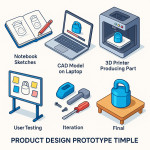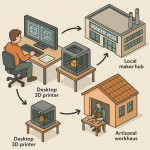Sustainable material sourcing plans that win eco-conscious object design briefs
The fastest route to an eco-conscious client's heart is a sourcing plan that proves you can reduce impact without blowing budgets or timelines. Follow this guide to craft a sustainable material sourcing plan that turns object design briefs into signed contracts—and repeat work.
Why clients demand sustainable sourcing in 2025
Key market drivers
Legislation, investor pressure and consumer activism are pushing brands to publish detailed life-cycle data. That means recruiters browsing the craft designer directory favour makers who bring a sustainable material sourcing plan to the first call.
- Regulation: Extended Producer Responsibility laws in the EU now require take-back schemes for many product categories.
- Procurement policies: 71 % of Fortune 500 companies have internal carbon pricing that affects purchasing decisions.
- Marketing value: “Made with 80 % recycled material” headlines lift conversion rates by up to 23 % in online campaigns.
Competitive advantage for independent object designers
Large brands move slowly. A freelancer who masters a sustainable material sourcing plan can outpace big in-house teams and secure fast-track briefs.
Seven-step sustainable material sourcing plan

Before diving into individual tactics, picture the entire journey of matter from extraction site to post-consumer recovery. Your plan must therefore weave together technical drawings, supplier audits, prototype data, logistics maps and end-of-life pathways into one coherent narrative. Spending time on this holistic storyboard helps clients grasp why each step—material hotspot mapping, measurable KPIs, supplier vetting, cost of ownership calculations, rapid prototyping, scalability scenarios and circular take-back programs—forms an interlocking chain rather than a loose checklist. By documenting how decisions at one node ripple downstream, you set clear expectations, surface risks early and build the trust needed to secure budget approvals for greener alternatives.
1. Map material hotspots in your concept
List every component, weight, and finish early. Use a simple spreadsheet to rank parts by mass and environmental risk. Focus effort where impact is highest.
2. Set measurable sustainability targets
Adopt clear KPIs before meeting suppliers: maximum 1.5 kg CO2 per unit, 60 % recycled content, or 100 % FSC certification. Targets make your sustainable material sourcing plan tangible.
3. Build a vetted supplier shortlist
Cross-check certifications (FSC, Cradle to Cradle, Fairmined). Interview at least three vendors per material to avoid single-source risk. For metals, see the tips in using eco-certified metals.
4. Calculate true cost, not just unit price
Include shipping distance, scrap rate and finishing energy. A recycled aluminium part may cost 15 % more per kilo but save 40 % on finishing because it machines easier.
5. Prototype fast and publish data
Rapid prototypes reveal machining issues early. Share timeline benchmarks inspired by industry-standard prototype timelines so clients see low risk.
6. Plan for small-batch scalability
Eco-conscious brands often start with limited runs. Document how your sustainable material sourcing plan adapts from 100 to 5 000 units. Need help? Review scaling pathways for object design orders.
7. Close the loop with end-of-life options
Offer take-back or modular replacement parts. Demonstrating a circular model boosts proposal scores in many corporate RFPs.
Supplier vetting checklist
| Criterion | Minimum requirement | Best-in-class proof |
|---|---|---|
| Certification | ISO 14001 or equivalent | Third-party LCA + Carbon Disclosure Project score A |
| Recycled content | >30 % | >90 % with batch traceability |
| Energy mix | >25 % renewables | 100 % on-site solar or PPA |
| Social audit | SEDEX SMETA 4-pillar | Fairtrade or B-Corp certified |
| Transport distance | <1 500 km | Local (sub-500 km) + low-emission freight |
Environmental impact comparison of popular materials
Source : US EPA Climate Leadership Data
Use data like this in your sustainable material sourcing plan to justify switching from virgin steel to recycled aluminium—for a 64 % CO2 drop at similar cost.
Case study: Bamboo table lamp prototype
A boutique hotel chain wanted bedside lamps with <1 kg CO2 each. We combined FSC bamboo ply, recycled aluminium heat sink and bio-based PLA diffuser film.
- Embodied carbon: 0.94 kg per unit (verified by simplified LCA).
- Lead time: 21 days from PO to prototype, thanks to regional suppliers.
- Outcome: Awarded a 1 200-unit contract and featured in their sustainability report.
Pitch deck must-haves
- Material flow diagram: visual map from source to end-of-life.
- LCA snapshot: one slide with kg CO2, water and waste data.
- Supplier certificates: thumbnails linked to PDFs.
- Scalability plan: reference to recycled supply chain examples if relevant.
FAQ
- How do I find reliable recycled material suppliers?
- Start with certification bodies' directories (FSC, GRS, Fairmined) and request batch certificates and audit reports before sampling.
- Does a sustainable material sourcing plan increase costs?
- Unit cost can rise 5-15 %, yet total project cost often drops through reduced finishing, shorter shipping and stronger marketing ROI.
- What software helps calculate environmental impact quickly?
- Free tools like OpenLCA or the Ecoinvent plug-in for Excel provide cradle-to-gate data adequate for early design decisions.
- Can small studios achieve circularity?
- Yes—offer repair kits, modular components and partner with local recyclers for take-back programs. Start small and scale.
Quick self-test: Are you sourcing like a pro?
Next step
Embed this sustainable material sourcing plan template in your next proposal, and bookmark the internal guides above. Clients will see a designer ready for tomorrow's regulations—today.
Need bespoke advice? Contact us for a sourcing audit that converts eco-aspirations into measurable results.











